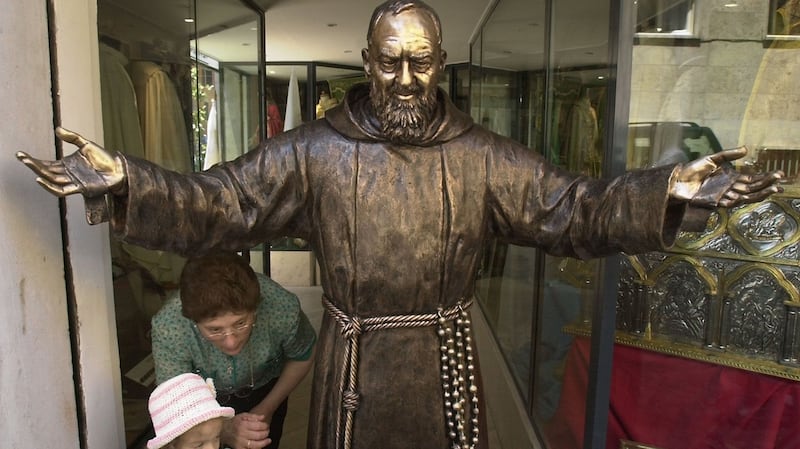Padre Pio, priest, stigmatist, mystic and one of the world's most popular saints, will be dead 50 years on Sunday, September 23rd. He has inspired extraordinary devotion worldwide but has caused controversy as well.
Born Francesco Forgione in Campania, southern Italy, in May 1887, one of five siblings of small farmers, up to the age of 10 he looked after the family's small flock of sheep and received three years' education in a local public school.
To realise his desire to join the Capuchin order he needed to be further educated, so his father emigrated to the US to get the money and at 15 he entered the novitiate taking the name Fra Pio (Friar Pius).
As a novice, he suffered various illnesses that have been interpreted by some as inexplicable phenomena such as religious ecstasy and levitation. Following ordination, he was sent to the Capuchin community in the province of Foggia in Puglia.
He remained in the town of San Giovanni Rotondo there for the rest of his life except for a period of military service with the medical corps in Naples during the first World War.
The stigmata, corresponding to Christ’s crucifixion wounds, first appeared on him 100 years ago in September 1918 and lasted until the end of his life. They didn’t deteriorate, nor did they heal and the blood from them was said to smell of perfume (often referred to in hagiography as the “odour of sanctity”).

Those close to him also testified that he displayed other extraordinary abilities such as healing, bilocation, prophecy and performing miracles.
Series of bans
The local bishop believed his Capuchin community were using him for financial gain. The papacy established many investigations and banned him from hearing confessions, from saying Mass in public, blessing people, responding to letters and displaying his stigmata publicly (he had to wear fingerless gloves).
He was banned him from hearing confessions, from saying Mass in public, blessing people, responding to letters and displaying his stigmata publicly
Those prohibitions remained in place under Pope Pius XI but in the mid-1930s he lifted the ban claiming he wasn't badly disposed towards Padre Pio but that he had been badly informed.
His successor, Pope Pius XII, encouraged people to visit Padre Pio, who had his critics. Some accused him of using carbolic acid to create and sustain his wounds. A hospital that he had planned and which was opened in 1956 also caused controversy, leading to accusations of misappropriation of funds.
But Paul VI, who became pope in 1963, dismissed all accusations against him.
Padre Pio died in 1968. Ten years later, after he became pope in 1978 John Paul II, who had visited him as a young priest while studying in Rome, began a canonisation process that saw him proclaimed St Padre Pio in 2002.
Irish people seem to have had a special affinity with Padre Pio. Many Irish visited him and some claimed to have been cured of serious illnesses by him. Colum Keane, in his recent best-selling book, Padre Pio: Irish Encounters with the Saint, recorded some of their testimonies.
Supernatural appearance
“I looked into his face and I got an awful fright. He looked supernatural. He was different from any other living being I have ever seen. He literally shone, and his eyes were remarkable. He was pale-featured, but he had a glowing expression,” was one such testimony.
He looked supernatural. He was different from any other living being I have ever seen. He literally shone, and his eyes were remarkable. He had a glowing expression
So, was he a modern incarnation of Jesus or was he a fraud?
His recipe for good human conduct was exacting and could be considered Christ-like: “living humbly, being disinterested, prudent, just, patient, kind, chaste, meek, diligent, carrying out one’s duties for no other reason than that of pleasing God, and receiving from Him alone the reward one deserves”.
In this sceptical age it is probably hard to believe that he could have had the stigmata but he was examined by many experts (although it is not clear how independent of the Church they were) and they had no logical, plausible explanation for the wounds he bore. It is possible that these wounds were self-inflicted but it seems difficult to be categorical either way.
It is also hard to believe that he performed miracles and actually cured people of their diseases, but the many testimonies of those who were convinced he cured them or their loved ones have been documented.
In the final analysis, how one feels about Franceso Forgione, more famously known as Padre Pio, probably comes down to the personal issue of faith or belief. Among believers, there is no doubt whatsoever about his enduring appeal.
Brian Maye is a journalist and historian












